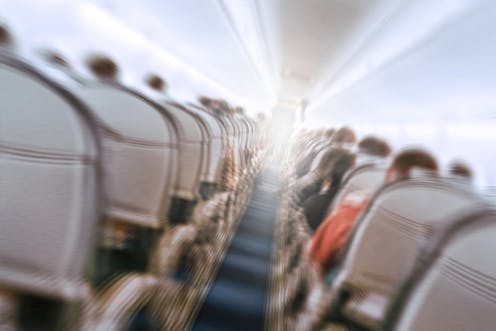How risky is turbulence on a plane? How worried should I be?
- Written by Hassan Vally, Associate Professor, Epidemiology, Deakin University

The Singapore Airlines turbulence incident[1] that has sadly left one person dead and others hospitalised has made many of us think about the risks of air travel.
We’ll hear more in coming days about how the aircraft came to drop so suddenly on its route from London to Singapore earlier this week, injuring passengers and crew, before making an emergency landing in Thailand.
But thankfully, these types of incidents are rare[2], and much less-common[3] than injuries from other types of transport.
So why do we sometimes think the risk of getting injured while travelling by plane is higher than it really is?
How common are turbulence injuries?
Turbulence[4] is caused by[5] the irregular movement of air, leading to passengers and crew experiencing abrupt sideways and vertical jolts.
In the case of the Singapore Airlines flight, this type of turbulence is thought to be a severe example of “clear-air turbulence[6]”, which can occur without warning. There are several other types.
About 25 in-flight turbulence injuries are reported[7] to the Australian Transport Safety Bureau each year, although it is thought many more are un-reported. Some of these reported injuries are serious, including broken bones and head injuries. Passengers being thrown up and out of their seat during turbulence is one of the most common type of head injury on a plane.
Other injuries from turbulence are caused by contact with flying laptops, or other unsecured items.
In one example[8] of clear-air turbulence that came without warning, cabin crew, passengers and meal trolleys hit the ceiling, and landed heavily back on the floor. Serious injuries included bone fractures, lacerations, neck and back strains, a dislocated shoulder and shattered teeth. Almost all of those seriously injured did not have their seat belts fastened.
But we need to put this into perspective. In the year to January 2024, there were more than 36 million[9] passengers on international flights to Australia. In the year to February 2024, there were more than 58 million[10] passengers on domestic flights.
So while such incidents grab the headlines, they are exceedingly rare.
Why do we think flying is riskier than it is?
When we hear about this recent Singapore Airlines incident, it’s entirely natural to have a strong emotional reaction. We might have imagined the terror we might feel if we were on the aircraft at the time.
But our emotional response alters our perception[11] of the risk and leads us to think these rare incidents are more common than they really are.
Read more https://theconversation.com/how-risky-is-turbulence-on-a-plane-how-worried-should-i-be-230665

















